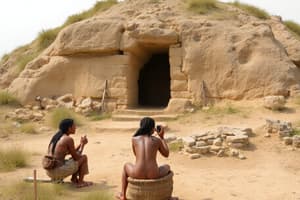Podcast
Questions and Answers
What characterized human societies during the Paleolithic period?
What characterized human societies during the Paleolithic period?
Hunter-gatherers
What formed the basis of subsistence and survival for hunter-gatherers?
What formed the basis of subsistence and survival for hunter-gatherers?
Pursuit of plants and animals
What was the primary method of obtaining food for Paleolithic hunter-gatherers?
What was the primary method of obtaining food for Paleolithic hunter-gatherers?
Foraging and hunting
How did the availability of resources influence the migratory patterns of hunter-gatherer groups?
How did the availability of resources influence the migratory patterns of hunter-gatherer groups?
What were the social structures of hunter-gatherer societies rooted in?
What were the social structures of hunter-gatherer societies rooted in?
What purpose did caves and rock shelters serve for Paleolithic humans?
What purpose did caves and rock shelters serve for Paleolithic humans?
How did hunter-gatherers adapt to the expansion of their territories?
How did hunter-gatherers adapt to the expansion of their territories?
What skills did humans develop as they manipulated their physical environment more?
What skills did humans develop as they manipulated their physical environment more?
What led to the end of the Paleolithic period around 12,000 BCE?
What led to the end of the Paleolithic period around 12,000 BCE?
What did the Paleolithic era and the hunter-gatherer way of life demonstrate about humans?
What did the Paleolithic era and the hunter-gatherer way of life demonstrate about humans?
Flashcards are hidden until you start studying
Study Notes
Paleolithic Hunter-Gatherers: A Fascinating Journey into Humanity's Origins
At the dawn of our species, Homo sapiens existed as hunter-gatherers, a way of life that defined the first 2.5 million years of human history. This era, known as the Paleolithic, saw the emergence and evolution of our ancestors, as well as our fundamental relationship with the natural world.
The Beginning of Human Culture
The Paleolithic period, which spanned from roughly 2.5 million years ago to 12,000 BCE, was marked by the earliest development of human culture, including tools, shelters, and social structures. While the early stages were characterized by simple stone tools, as time passed, humans began to diversify their toolsets, including the iconic spear points, axes, and blades used for hunting and food processing.
A World of Hunter-Gatherers
During the Paleolithic, human societies were predominantly composed of hunter-gatherers, for whom the pursuit of plants and animals formed the basis of their subsistence and survival. These nomads were adept at navigating the natural environment, moving from place to place in search of food and resources.
Hunter-gatherers typically relied on a diverse array of plants and animals for nutrition. They would forage for fruits, nuts, and vegetables, and hunt for a wide range of animals, such as deer, bison, and fish. The human diet during this period was seasonal, with the availability of resources shaping the migratory patterns of these groups.
The Clan and the Cave
Hunter-gatherer societies were often divided into small clans, made up of extended families. These groups shared knowledge, resources, and responsibilities, ensuring the survival of their members. Their social structures were rooted in traditions, rituals, and spiritual beliefs, all of which were passed down from generation to generation.
In the Paleolithic, humans began to inhabit caves and rock shelters, creating temporary or semi-permanent residences. These dwellings provided protection from the elements and served as a hub for socializing, sharing, and learning.
The Evolution of the Hunter-Gatherer
Hunter-gatherers faced challenges that required them to adapt and evolve. For instance, the expansion of their territories led to the need for efficient communication and cooperation among groups. Consequently, humans began to develop sophisticated systems of body language, vocalizations, and gestures to facilitate communication.
As humans began to manipulate their physical environment more, they developed and perfected their skills in creating tools and weapons using stone, bone, and wood. The use of tools and weapons not only ensured their survival but also provided them with a means of expression and self-identification.
The End of an Era
The Paleolithic period came to an end around 12,000 BCE, as the world began to undergo dramatic climatic changes that led to a shift in the human way of life. These changes paved the way for the development of agriculture, the formation of more complex societies, and the emergence of new technologies that continue to shape our world today.
The Paleolithic era, and the hunter-gatherer way of life it represents, serves as a testament to human adaptability, resilience, and creativity. By studying this period, we can gain valuable insights into the earliest stages of our evolution and the foundations of our society.
Studying That Suits You
Use AI to generate personalized quizzes and flashcards to suit your learning preferences.




